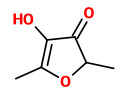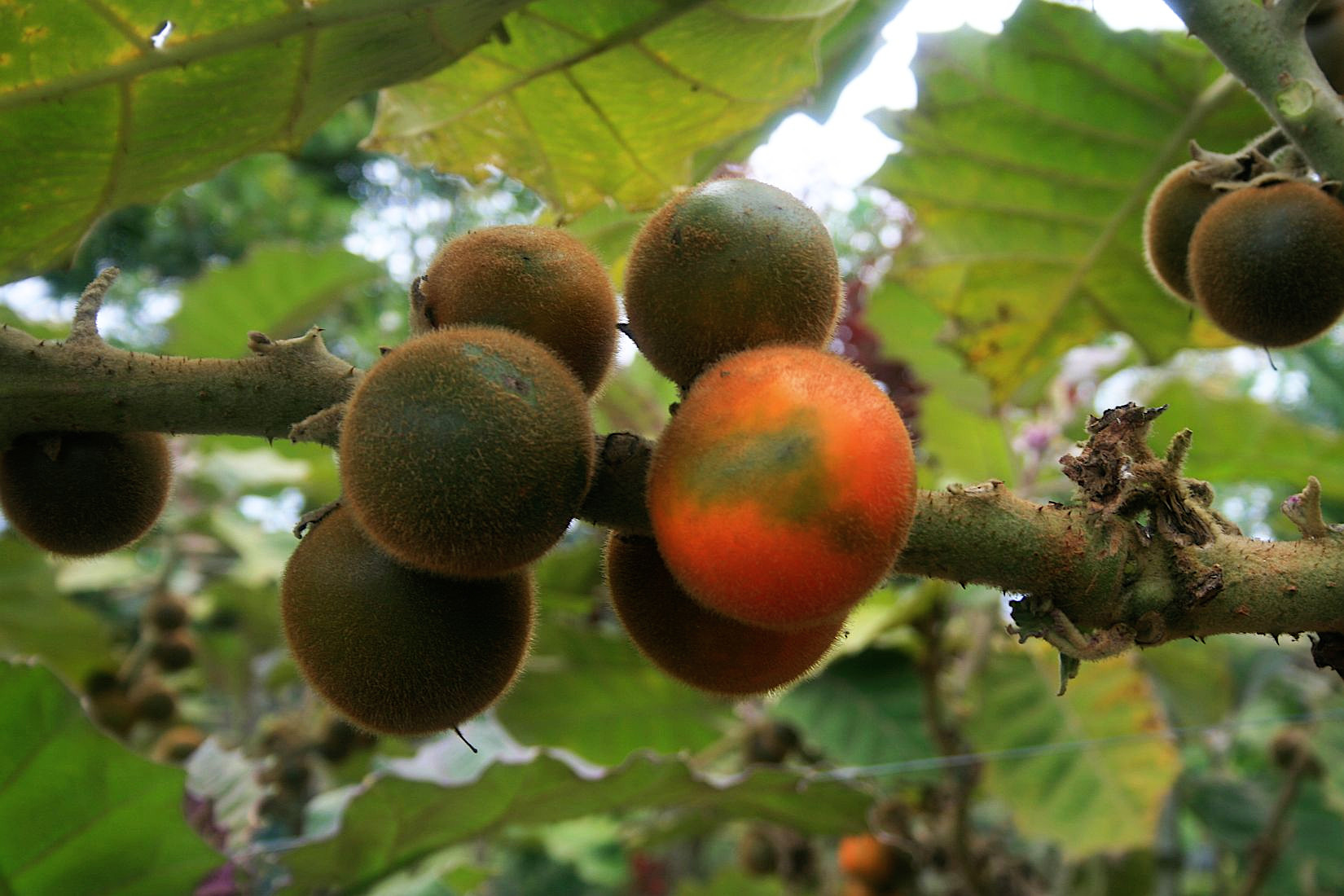Solanum quitoense Lam. - Solanaceae - lulo, naranjilla, Quitotomate, Quitorange
Perennial subshrub, 1-1.5(-2.5)m tall, native to the South American Andes; leaves petioled (5-15cm), oblong-ovate, highly pubescent, 60cm long and 45 across; early flower buds purple, flowers individually or in clusters of up to 10 cymes on the leaf axils and on secondary branches, flowers about 3 cm wide, with five white petals, sepals smooth-green with purple pubescences on the abaxial surface.
„A brown, hairy coat protects the fruit until it is fully ripe, when the hairs can be easily rubbed off, showing the bright-orange, smooth, leathery, fairly thick peel. The fruit, crowned with the persistent, 5-pointed calyx, is round or round-ovate, to 2 1/2 in (6.25 cm) across and contains 4 compartments separated by membranous partitions and filled with translucent green or yellowish, very juicy, slightly acid to acid, pulp of delicious flavor which has been likened to pineapple-and-lemon. There are numerous pale-buff seeds, thin, flat, hard and 1/8 in (3 mm) in diameter… Ripe naranjillas, freed of hairs, may be casually consumed out-of-hand by cutting in half and squeezing the contents of each half into the mouth. The empty shells are discarded. The flesh, complete with seeds, may be squeezed out and added to ice cream mix, made into sauce for native dishes, or utilized in making pie and various other cooked desserts.“
[Morton, J. 1987. Naranjilla. p. 425-428. In: Fruits of warm climates. Julia F. Morton, Miami, FL.] Naranjilla (Purdue)
„Lulo fruits are common in local markets and are commonly used for juice (Ramírez pers. Obs.). The fruit can be eaten raw or preserved as juice in canned, frozen, or concentrated forms, jellies, jams, as part of cakes, ice-cream, yogurt, and as an ingredient of fruit salads…
The fruit is an aromatic, spherical berry, 4 to 6.5 cm in diameter and 40-120 g in weight containing four distinct locules filled with a translucent green to yellowish pulp that contains seeds. The pulp is acidic, edible, and juicy with 82-92% moisture content and 7.3-10.2°Bx. Immature fruits are green with hairs on them. Maturing fruits have a leathery orange skin with brown, brittle hairs that are easily removed by hand. Lulo is
also known for its healthful properties such as a high antioxidant potential in contrast to other fruits. Lulo fruit has a high content of vitamin A (600 units per 100 g fresh wt.) and ascorbic acid (Vitamin C) (25 mg/100 g fresh wt.), which adds to its nutritional value…
Lulo, Solanum quitoense, has two forms, the spiny form, classified as S. quitoense var. septentrionale, and the spineless or unarmed form named S. quitoense var. quitoense. The hardy variety, septentrionale, grows from 1000 to 1900 m altitude in central Colombia through the isthmus of Panamá to Costa Rica, whereas var. quitoense is native to the Andes region of southern Colombia, Ecuador, Venezuela, and Peru… The variety, septentrionale, has purple veins and purple pubescences covering leaf petioles, stems, and leaf veins, whereas quitoense displays white veins.“
[Ramírez, Fernando, and Thomas L. Davenport. „The development of lulo plants (Solanum quitoense Lam. var. septentrionale) characterized by BBCH and landmark phenological scales.“ International Journal of Fruit Science 20.3 (2020): 562-585] PDF
„The fruit has a citrus flavour, sometimes described as a combination of rhubarb and lime. The juice of the naranjilla is green and is often used as a juice or for a drink called lulada.“ wikipedia (retrived 20251003)
The tomato-sized, orange fruits resembling in taste a mixture of strawberry, pineapple and banana. Aroma volatiles from naranjilla fruit (Solanum quitoense Lam.) were concentrated (closed-loop stripping or solvent extract) and characterised by GC-MS and GC-O. The main aroma constituents were ethyl butyrate (26.7%), methyl butyrate (12.1%), and γ-hexalactone (8.2%). Minor components were methyl crontonate (0.9%), methyl hexanoate (0.4%), butyric acid (0.4%), and methyl benzoate (0.3%) e.g. Esters contribute much to the typical naranjilla flavor, but unidentified substances that possess strong odors play an important role in the complex flavor of the fruit.
[Brunke E-J, Mair P, Hammerschmidt F-J. Volatiles from naranjilla fruit (Solanum quitoense Lam.). GC/MS analysis and sensory evaluation using sniffing GC. J. Agric. Food Chem. 1989; 37: 746-748]
Major volatile components of the pulp of naranjilla (Solanum quitoense Lam.) were methyl butyrate (54.3%), 4-hydroxy-4-methyl-2-pentanone (13.2%), butyric acid (8.3%), methyl benzoate (5.7%), ethyl butyrate (4.0%), methyl hexanoate (3.8%), methyl crotonate (3.4%), methyl 3-hydroxyhexanoate (2.8%), γ-hexalactone (2.3%), and 2-methyl-2-pentenal (1.9%).
[Acosta, Óscar, Ana M. Pérez, and Fabrice Vaillant. „Chemical characterization, antioxidant properties, and volatile constituents of naranjilla (Solanum quitoense Lam.) cultivated in Costa Rica.“ Archivos latinoamericanos de nutrición 59.1 (2009): 88-94] PDF
„They are eaten fresh or used for ice creams, sauces and most frequently for a delicious drink which is much valued in Andean countries…the fruits have to be harvested nearly ripe for their typical aroma (cp. 75% maturation for Solanum vestissimum: Suárez and Duque, 1992) and moreover soften and ferment quickly when stored, whereas canned juice loses much of its taste. The lulo with its exotic taste and high nutrition values appears to be a potential species for global markets.“
[Messinger, Jana, and Marianne Lauerer. „Solanum quitoense, a new greenhouse crop for Central Europe: Flowering and fruiting respond to photoperiod.“ Scientia horticulturae 183 (2015): 23-30]
 3-sulfanylhexyl acetate (tropical fruity, black currant-like) |  4-hydroxy-2,5-dimethyl-3(2H)-furanone (DHF, HDMF, furaneol) (sweet, cotton candy-like) |
GC-MS and GC-O showed that (Z)-3-hexenal, ethyl butyrate, 3-sulphanylhexyl acetate, and ethyl hexanoate were key aroma compounds of lulo fruit. „Other odorants with relevance because their contribution (high OAVs) to the overall aroma were 4-hydroxy-2,5-dimethyl-3(2H)-furanone, methyl benzoate, (E)-2-hexenal, and hexanal.“
[Forero, Diana Paola, et al. „Chemical and sensory comparison of fresh and dried lulo (Solanum quitoense Lam.) fruit aroma.“ Food chemistry 169 (2015): 85-91]
Volatile compounds of lulo pulp (HS-SPME/GC-MS) were esters (49%), aldehydes (18%), and alcohols (14%), with 3-hexen-1-ol acetate, methyl acetate, hexyl acetate and ethyl acetate as main components. Minor components were also ketones like 2-methyl-3-octanone, acetophenone, and 5-ethyldihydro-2(3H)-furanone.
[Iguaran, Eduardo Javid Corpas, Gonzalo Taborda Ocampo, and Omar Alberto Tapazco Alzate. „Analytical approach of the volatile fraction of solanum quitoense by hs-spme/gc-ms.“ Biotecnología en el Sector Agropecuario y Agroindustrial 15.1 (2017): 76-84] PDF

Solanum quitoense, Colombia: Dpto. Huila (2017)
CC BY-SA 4.0 Franz Xaver Wikimedia Commons
